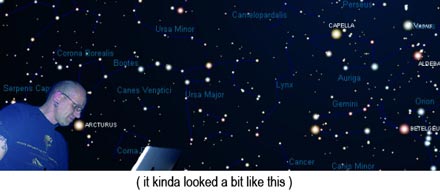“The history of immersive projection dates back many thousands of years. From the earliest connections visualized between radiant points on the celestial screen, humans have projected literal or metaphorical devices through their imaginations onto the vault of heaven.”
– from http://elumenati.com, a company dedicated to the art of domed projections, featuring video artist Johnny DeKam ( founder of vidvox + vdmx vj software).
From the Top Of The Dome
Surround sound, a 3-4 storey high dome, lay-back seating for around 100 and a bunch of sonic maestros fiddling about under the simulated heavens. Such is life at the Melbourne Planetarium( On the evening of Feb 2nd, 2008 anyway. ). Nat Bates of Liquid Architecture started the evening off with a granular deconstruction of classic rock songs. Never heard enough to recognise the riffs when the sound was stripped back to raw guitar, but a nice enough piece unfolding beneath the dotted stars. Steve Law + Ollie Olsen, veterans of sonic mutation, followed next with a textural exploration that flirted with percussion by it’s close. Performing as the Mutagen Server, their fluid interweavings were accompanied by films on the dome by Sonia Leber + David Chesworth. Drone based noodling isn’t for everybody, but a novel setting like this is more forgiving than most places. A short break and then..
Robert Henke introduced his hour long piece, Layering Buddha, by explaining how the Chinese music group FM3 had made this ‘Buddha Machine‘ that he loved, a small electronic device that played 9 different mantras. As it turns out, their cheap electronic manufacture means tha the machines played side by side develop all kinds of layers and inconsistencies, which Robert ( aka Monolake & the creator of Ableton Live ) recorded, relayered and remixed to produce his Layering Buddha album. Performed live, we get super-rich textures that ebb and flow, a slow sonic choreography over the hour, matched by a gradual shift overhead of the stars set to Melbourne at the start, and Robert’s Berlin by the end. The gentle shifting of the stars proved somehow soothing, but joltingly interrupted 3/4 of the way through when a large black rectangle appeared in the sky. Either one of the projectors had crapped out or a great piece of German minimal design, it felt like a building ( or black Kubrick monolith ) was falling through the sky, created a surprisingly real presence overhead. Minutes later the direction of the star movement reversed suddenly and sped up dramatically. The top edge of the wall beneath the dome, effectively a horizontal line around the room, suddenly started swinging wildly like a boat edge in heavy seas. The music faded out shortly after, but the star movement continued to shift directions, and no-one said a word, content to be there floating in space. (see also )
More Domes

Vidvox founder Johnny DeKam now uses his videoprogramming and VJ chops bending pixels to fit on domed ceilings, as part of the Elumenati crew. Rather than the multiple projector installation at the planetarium, they work with single projector solutions for immersive environments, using Omnifocus fisheye projection systems to project without need for edge blending or alignment.
Also dedicated to panoramic projections is Chromatouch ( found via cdm ), a blog by Leon Trimble (UK), which includes the following breakdown of the core issues involved with immersive projections :
1) choreography of the camera – (thinking outside of the frame, editing for immersion, precise control of actors/dancers/camera in an inescapable environment, wearable computing/camera )
2)capture of 360° video – (camera arrays/stitching, fisheye lenses, ultra hd, telematics, mimetics )
3) presentation of 360° video (dome structures, customisable distortion maps for ‘generic’ rooms, edge blending/masking, projector arrays, fisheye projection, kinesthetics, viewer tracking/perspective shift )
And Spheres
Musica universalis ( or ‘music of the spheres’) is an ancient philosophical concept that regards proportions in the movements of celestial bodies — the Sun, Moon, and planets, as a form of music. This I discovered within Walter Murch‘s delightful book about editing, sound, cinema – In the Blink of An Eye. Editor on the Godfather series, Apocalypse now and The Conversation, Murch has plenty of incredible experience and anecdotes to pass on, but comes across as an incredibly curious character who draws on a huge breadth of human knowledge to inform his editing. He recommended The Music of the Spheres : Music, Science and the Natural Order of the Universe, by Jamie James, which amazon.com’s secondhand section finally delivered yesterday.


Sounds like a great show — shame I was 10,000 miles away.
One amazing thing about Walter Murch is that he can play the music of the spheres on the piano. I think I read that in The Conversations.
[…] Quick News, Links, Bits, Reads: A belated R.I.P. for Teo Macero, studio maven and Miles Davis fellow maverick (latimes.com, nytimes.com, jazztimes.com, pitchforkmedia.com). … The Mosquito, a high-pitched anti-truancy weapon mentioned here previously (disquiet.com, disquiet.com), is under investigation by England’s commissioner for children (nytimes.com). … Creating music from Pi at (avoision.com, via engadget.com and boingboing.net). … Circular analog synth (future-retro.com, via engadget.com). … Why do beluga whales enjoy the clarinet note G? Ask collisiondetection.net. … Urban sound is one of the factors that Dan Hill wrestles with in his essay on “the street of the future” (cityofsound.com, via williamgibsonbooks.com). … A review of a Robert Henke (aka Monolake) performance at a planetarium (skynoise.net). … Heather Powazek Champ mediates on a “bag of hush” (hchamp.com). … An album made entirely from the Kaossilator (createdigitalmusic.com). … An “instrument” by Jun Murakoshi that amplifies the world, much like a seashell (junmurakoshi.com, via boingboing.net). It’s a prototype, so you can’t purchase one down by the seashore yet. … Thread on “victorian synthesizer” at the freakangels.com/whitechapel forum, spun from the steampunk webcomic. … An album of Kraftwerk covers ends with a cease and desist form Sony (audioobjekt.com). Apparently the Fourth Law of Robotics has to do with not coveting thy neighbor’s source code. […]